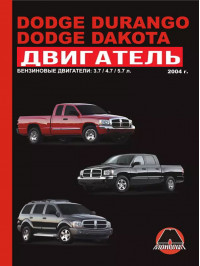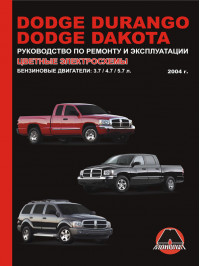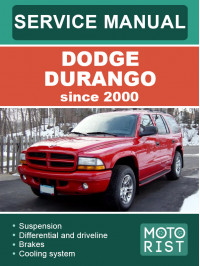Information on repair and maintenance of Dodge Durango cars electronically
The Dodge Durango is an SUV from the Dodge brand, part of the Stellantis Group. The first generation, released for the 1998 model year, was the successor to the Dodge Ramcharger, which was discontinued in 1993. The second generation was released in 2004 and was revised for the 2007 model year. The Dodge Durango was produced at the Newark Assembly Plant in Newark, Delaware.
The first Dodge Durango was introduced shortly after the introduction of the second generation Dodge Dakota, on which platform it was based. In the late 1980s, Chrysler designers proposed building an SUV based on the Dakota pickup truck. However, at that time the project was abandoned in favor of the Jeep Grand Cherokee brand.
The model features a robust ladder frame design with an attached body, capable of carrying up to seven passengers and a towing capacity of up to 4.0 tonnes. The 4.7 L PowerTech V8 engine replaced the 5.2 L engine starting with the 2000 model year. The same year, a high-performance version called R/T with all-wheel drive and a 5.9-liter engine was also released.
The second generation Dodge Durango appeared in the fall of 2003, shortly before the appearance of the new Dodge Dakota. Like the Dakota, it shared many similarities with the full-size Dodge Ram pickup, such as the ladder frame. The new generation was 7 inches (about 18 cm) longer, 2 inches (about 5 cm) wider and 3 inches (about 8 cm) taller than the previous model. In the 2007 model year, Chrysler introduced its own version of this model - the Chrysler Aspen.
In April 2006, a redesigned version of the Dodge Durango debuted at the Dallas Auto Show for the 2007 model year due to declining sales. Particular attention was paid to the new front end design, which gives the car a fresh look. The front fenders received new plastic, the hood was completely different, and the headlights and grille were redesigned, giving the car a more modern look. A new front bumper with an original protective trim added additional character to the car.
The list of equipment included such long-awaited functions as a motion stabilization system, a tire pressure monitoring system and rear parking sensors, which made driving and parking more convenient and safe for the driver. The engineers also paid attention to environmental aspects, making the car more environmentally friendly, which meets modern requirements for the automotive industry.
Inside, the air conditioning controls have been revised and the second and third row seats have been redesigned. Technical changes were limited to a new design of the car floor and improvements to the electronics.
The car was equipped with a new 4.7-liter V8 engine, which has the ability to run on both gasoline and alcohol, in particular E85 ethanol, or even optionally combine both types of fuel. The power of this engine is 230 horsepower. The move underscores Durango's commitment to greener, more versatile performance while meeting today's vehicle needs and expectations.
Since the end of 2008, the car has been available for some time in a hybrid version. This was the Advanced Hybrid System 2, developed jointly with GM in conjunction with the Chrysler Hemi V8 engine. Just weeks after production of the hybrid model began, all production of the Durango and the parallel Chrysler Aspen model was stopped due to lack of demand. Due to overproduction, both models were available as new cars for a time until mid-2009.
The third generation Dodge Durango has been available on the US market since the fall of 2010. The car has been completely redesigned with virtually unchanged dimensions - except that the height of the car has become lower by about 10 cm. The model is built on the same platform as the modern Jeep Grand Cherokee.
As with all Dodge vehicles, the V6 engine is a new Chrysler Pentastar unit with significantly more power, so the smaller V8 engine was not used. The Durango R/T's 5.7-liter HEMI V8 engine features cylinder deactivation. Both versions are optionally available with all-wheel drive.
For the 2014 model year, minor changes were made to the design (LED daytime running lights, the brand's signature rear end with all-round red illumination (LED)). In the interior, the cabin has been significantly redesigned and now offers a 5- or 8-inch infotainment system (uConnect) and a central 7-inch screen with flexible displays such as the speedometer, fuel consumption or audio system.
The biggest change is the introduction of an 8-speed automatic transmission in all models, which has a positive effect on driving performance and fuel consumption.
Unique materials on servicing and repairing Dodge Durango vehicles are available on our website. You can not only read the information for free, but also purchase and download books in PDF format. This is convenient because you can always access them on your mobile device or tablet.
Each book provides comprehensive answers to a variety of questions that Dodge Durango owners may have, such as:
- procedure for changing engine oil yourself;
- how to identify and eliminate faults in the fuel system;
- structure and problems of electrical equipment of a car;
- how to prepare for clutch pedal repair;
- possible causes of engine malfunctions;
- procedure for replacing the coolant pump yourself and much more.
Using these guides, you can reduce the time and financial costs of servicing your vehicle. Detailed instructions with step-by-step descriptions and illustrations will help you understand any problem. All experience and recommendations are presented in accessible and understandable language, which makes the use of this information as efficient and convenient as possible.





